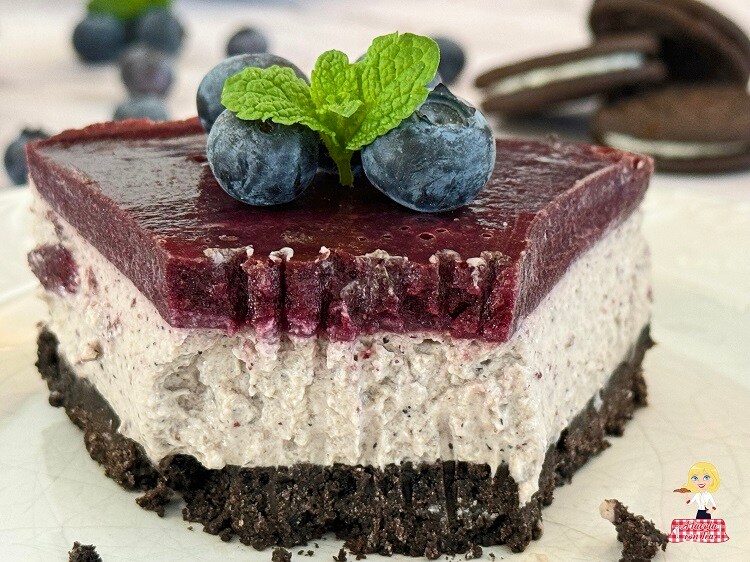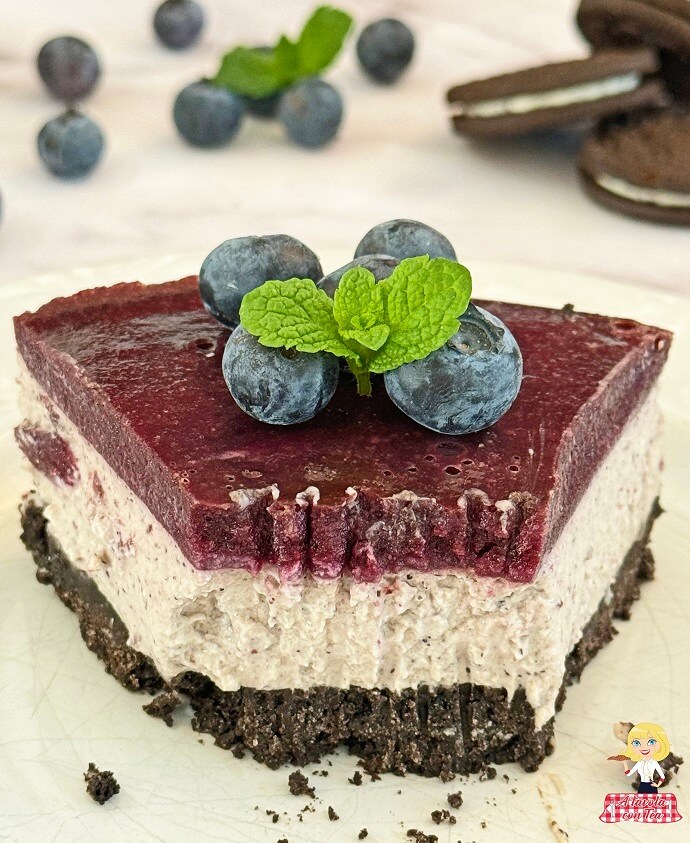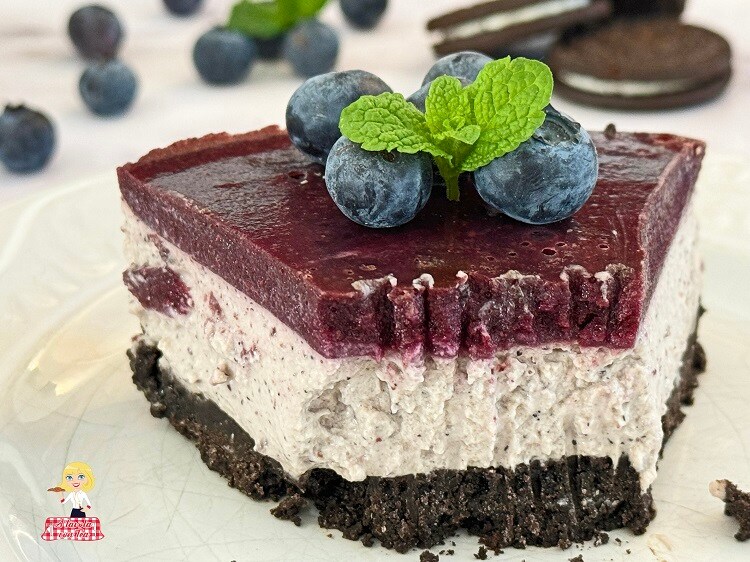OREO CHEESECAKE with BLUEBERRIES
The no-bake OREO CHEESECAKE is a cold cake born in America and also known as OREO DREAM PIE now spread worldwide.
As you can easily deduce from the name, the recipe features OREO cookies, two dark, almost black cocoa cookies that contain a vanilla cream inside.
These are used in the cookie base and as decoration along with dollops of whipped cream.
Like all recipes, there are several versions and variations. Today we will prepare the Oreo Cheesecake Tart with Blueberries, a winning combination in my opinion because the slight tartness of this fruit pairs well and balances the sweetness of the mixture and cookie base.
The cream of the no-bake OREO Cheesecake is mainly composed of cream cheese, whipped cream, and condensed milk instead of sugar, along with a simple blueberry puree blended cold and mixed with gelatin sheets necessary in no-bake desserts to give the cake consistency.
An easy and quick recipe perfect as a summer dessert when you don’t want to turn on the oven due to the high temperatures, as a birthday cake or to celebrate special occasions. A perfect dessert for fruit cake lovers and those who love creamy spoon desserts adored by both adults and children that will win you over at the first taste.
Related recipes

- Difficulty: Easy
- Cost: Expensive
- Rest time: 1 Hour
- Preparation time: 45 Minutes
- Cooking methods: No-bake
- Cuisine: Italian
- Energy 434.49 (Kcal)
- Carbohydrates 46.54 (g) of which sugars 33.76 (g)
- Proteins 7.45 (g)
- Fat 25.71 (g) of which saturated 6.35 (g)of which unsaturated 6.52 (g)
- Fibers 2.83 (g)
- Sodium 210.67 (mg)
Indicative values for a portion of 80 g processed in an automated way starting from the nutritional information available on the CREA* and FoodData Central** databases. It is not food and / or nutritional advice.
* CREATES Food and Nutrition Research Center: https://www.crea.gov.it/alimenti-e-nutrizione https://www.alimentinutrizione.it ** U.S. Department of Agriculture, Agricultural Research Service. FoodData Central, 2019. https://fdc.nal.usda.gov
Ingredients
- 24 Oreo® cookies
- 3.5 oz butter
- 1.5 tsp gelatin sheets
- 2.2 cups blueberries
- 0.63 cups heavy cream (to be whipped)
- 0.84 cups condensed milk
- 6 oz cream cheese
- 1 cup blueberries
- 0.8 tsp gelatin sheets (agar agar)
- Oreo® cookies
- blueberries
- whipped cream (optional)
- A few leaves mint (optional)
Tools
- Mixer
- Electric Whisk
- 3 Bowls
- Springform Pan
Steps
Put the Oreo cookies in the mixer bowl, finely chop them, then add the melted butter and mix. Pour the mixture into a 9-inch springform pan and use the back of a spoon to create the cake base. Freeze for about 20 minutes to set.
Meanwhile, blend the blueberries with an immersion blender until smooth. Set aside 2 tablespoons. In the remaining part, add the gelatin previously dissolved in 2 tablespoons of warm water and mix.
In the blender cup, whip the cream at medium-high speed until stiff peaks form. Slowly add the condensed milk and blend again until well combined. Set aside 2 tablespoons of the mixture (you’ll need them for garnish). Add the whipped cream and condensed milk mixture to the blueberry puree and mix until combined.
Pour the filling onto the Oreo crust, level with a spatula, and chill in the fridge for at least 1 hour and 30 minutes to set.
Blend the blueberries with an immersion blender until smooth. Dissolve the gelatin powder in a little warm water. Add the gelatin to the blueberry puree. Heat in a double boiler, stirring to combine for about 2 minutes. Remove from heat and let cool slightly.
Remove the Blueberry Oreo Cheesecake Tart from the refrigerator, pour the blueberry glaze in the center, and gently rotate the pan to spread it evenly. Chill in the fridge for about 20 minutes. Remove the cake from the pan and garnish as desired with fresh blueberries and halved Oreos (or mini Oreos) and a few mint leaves. Serve cold.


NOTES and VARIATIONS
INGREDIENTS AND PAN SIZE The recipe quantities refer to a 9-inch diameter springform pan. If you want the Tart to be taller with the same quantities, use a 7-inch pan. It is generally advisable to prepare these types of cakes in a springform pan to facilitate removal since it cannot be flipped.
CREAM When whipping the cream, it should be well chilled from the fridge. To ensure it whips well, you can place the bowl in the freezer for 10-15 minutes or in the refrigerator for 30 minutes before working with the beaters.
GELATIN SHEETS They are essential for the cake to solidify and be sliceable without melting. I used 200 Bloom grade gelatin sheets. Alternatively, you can also use AGAR AGAR, but the quantities and method of use differ. To correctly substitute Gelatin sheets with Agar Agar, note that 10 g of 200 Bloom gelatin sheets can be substituted with 3.7 g of Agar Agar.
OREO COOKIES If you purchase Oreo cookies in the tube pack, 154 g per package, you will need 2 tubes of Oreos to prepare a 9-inch cheesecake. If you don’t have a food processor to pulverize the cookies, place them in a freezer bag and use a rolling pin.
BLUEBERRIES You can also prepare this cake with other types of berries like strawberries, raspberries, or blackberries. If using these other types of fruit, I recommend, due to the presence of seeds, to strain them through a fine mesh sieve after blending. Use only fresh fruits: frozen fruits are great in smoothies but not in a no-bake tart because they are too waterlogged.
CREAM CHEESE If you don’t like the taste of cream cheese, you can substitute it with the equivalent amount of mascarpone, which has a less strong and more delicate flavor, although it’s more caloric.
CONDENSED MILK: Add the condensed milk to the whipped cream slowly, but if it starts to deflate, don’t worry. Once added to the blueberry and gelatin mixture and cooled, the gelatin will solidify everything.
STORAGE
This cake can be stored in the fridge for up to 2 days in an airtight container.
If you prefer, you can freeze it, and it lasts up to 1 month, whole or portioned, better if without surface decoration. Thaw it the day before serving by transferring it from the freezer to the fridge, letting it gradually thaw. Once thawed, you can decorate it with cookies and dollops of whipped cream.
FAQ (Frequently Asked Questions)
What is the difference between Gelatin sheets and Agar agar?
Agar agar is a natural gelling agent obtained from the processing of red algae, while Gelatin, which was historically extracted from the bladder of certain fish (hence the name), is now mainly derived from the stomach and skin of cattle and sheep.
How many types of Gelatin sheets are there?
How many types of Gelatin sheets are there?
The gelatin sheets differ based on their “gelling power,” which is the ability to thicken liquid compounds: the gelling power is calculated in Bloom grades, assigned to gelatin based on the weight of grams it can thicken. In the market, we find three types of gelatin: 130 Bloom (bronze), 160 Bloom (silver), 200 Bloom (gold), and 240 Bloom.What are Bloom Grades?
Gelatin is assigned a gelling power based on the weight of grams it can thicken. This unit of measurement is called Bloom Grades, which determines the gelling capability of the gelatin in liquid compounds. Based on this distinction, we can find three types of gelatin sheets: 130 Bloom, 160 Bloom, and 200 Bloom: the higher the Bloom grades, the less gelatin is needed, and the faster the gelatinization process. Agar agar, regardless of the consistency in which it is presented, always has a gelling power of 650 Bloom grades.
What is the gelling power of Agar Agar?
Agar agar, regardless of the consistency in which it is presented, always has a gelling power of 650 Bloom grades.
How to replace Gelatin sheets with Agar Agar?
Since the thickening power of Agar Agar is always 650 Bloom grades, if we want to replace Gelatin sheets with this vegetable thickener in a recipe, we must proceed as follows. Considering a recipe that uses 10 g of 200 Bloom Gelatin sheets. In this case, 10 g of gelatin sheets will correspond to 2000 Bloom grades (200 Bloom grades x 10 g). To replace it with Agar Agar, considering that it always has a value of 650 Bloom grades per gram, we should divide 2000 (Bloom grades needed for the recipe) by 650 (Bloom grades per 1 g of Agar Agar) and we get 3.7 g. In conclusion, 10 g of 200 Bloom Gelatin sheets correspond to 3.7 g of Agar Agar.

